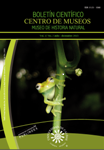Authors
Abstract
The aim of this work was to make an inventory of oribatid mite families associated to six land uses: a silvopasture arrangement, a potato crop in rotation with pastures, a potato crop, a bank forage protein, a plot of three grasses and clover mixed and a secondary forest. The variables abundance, richness and diversity index were measured; data was subject to variance analysis using Fishers least significant difference test (LSD). Nine families of the Oribatida order: Ceratozetidae, Mochlozetidae, Oppidae, Haplozetidae, Galumnidae, Plasmobotidae, Pheroliodidae, Tectocepheidae and Euzetidae were identified; the first three families were the most abundant, representing more than 70% in all land use systems. The ecosystem that showed the highest abundance and biodiversity of oribatid mites was the secondary forest ecosystem in relation to the different systems. The potato system presented fewer species. Also the silvopasture system, the protein bank and the forest had higher values in relation to species diversity compared to potato system, in which a negative effect of soil mite fauna possibly due to high use of agrochemicals such as fertilizers and pesticides.
Keywords
References
BALOGH, J. & BALOGH, P., 1988. Oribatid mites of the neotropical region I (en) BALOGH, J. & MAHUNKA, S. (eds.) The soil mites of the world. Vol. II. Elsevier; Budapest: Akade'miai.
________, 1992. The oribatid mites genera of the world. Vol. I y II. Hungarian Natural History Museum, Budapest.
BEDANO, J.C., CANTÚ, M.P. & DOUCET, M.E., 2005. Abundance of soil mites (Arachnida: Acari) in a natural soil of central Argentina. Zoological Studies, 44: 505-512.
BEHAN-PELLETIER, V.M., 1999. Oribatid mite biodiversity in agroecosystems: role for bioindication. Agric. Ecosyst. Environ., 74 (1-3): 411-423.
CORREIA, M. & OLIVEIRA, L.C.M., 2000. Fauna de solo: aspectos gerais e metodológicos. Seropédica: Embrapa Agrobiologia, No. 112.
ELLIOTT, E.T., HUNT, H.W. & WALTER, D.E., 1988. Detrital foodweb interactions in North American grassland ecosystems. Agric. Ecosys. Environ., 24 (1-3): 41-56.
GERGÓCS, V. & HUFNAGEL L., 2009. Application of oribatid mites as indicators. Applied ecology and environmental research, 7 (1): 79-98.
GONZÁLEZ, V., DÍAZ, M. & PRIETO, D., 2003. Influencia de la cobertura vegetal sobre las comunidades de la mesofauna edáfica en parcelas experimentales de caña de azúcar. Revista Biología, 17: 18-25.
INSTITUTO GEOGRÁFICO AGUSTÍN CODAZZI –IGAC–., 2004. Estudio general de suelos y zonificación de tierras. Departamento de Nariño. Bogotá: IGAC. CD-ROM.
ITURRONDOBEITIA, J., CABALLERO, A. & ARROYO, J., 2004. Avances en la utilización de los ácaros oribátidos como indicadores de las condiciones edáficas. Munibe (Suplemento/Gehigarria) 21: 70-91.
KRANTZ, G.W., 1978. A manual of acarology. 2nd ed. Corvallis: Oregon State University, Book Stores Inc. 509 p.
LINDO, Z. & WINCHESTER, N.N., 2007. Oribatid mite communities and foliar litter decomposition in canopy suspended soils and forest floor habitats of western redcedar forests, Vancouver Island, Canada. Soil Biology & Biochemistry, 39: 2957-2966.
MAGURRAN, A., 1988. Ecological diversity and it's measurement. New Jersey: Princeton University Press.
PRIETO, D., GONZÁLEZ, C. & TCHERVA, T. 2005. Microartrópodos asociados a la hojarasca de un Bosque Semideciduo de Bacunayagua, Matanzas, Cuba. Revista Cubana de Ciencias Biológicas, 19 (1-2): 57-65.
SANYAL, A.K., 1990. Influence of agricultural practices on the population of soil mites in West Bengal, India: 333-340 (en) VEERESH, G.K., RAJAGOPAL, D. & VIRAKTAMATH, C.A. (eds.) Advances in management and conservation of soil fauna. Oxford & IBH Publ., India.
SEASTEDT, T.R., 1984. The role of microarthropods in the decomposition and mineralization of litter. Ann. Rev. Ecol. System., 29: 25-46.
SOCARRÁS, A. & RODRÍGUEZ, M.E., 2004. Utilización de la mesofauna como indicador biológico en áreas recultivadas con Pinus cubensis en la zona minera de Moa, Holguín, Cuba. (en) Memorias del Primer Encuentro Internacional sobre Restauración Ecológica. Santa Clara, Las Villas, Cuba. [CD-ROM].

 PDF (Español)
PDF (Español)
 FLIP
FLIP


















